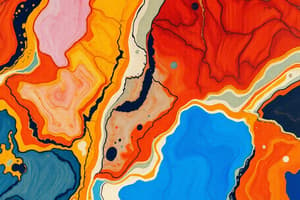Podcast
Questions and Answers
Which characteristic is essential for a rock to become metamorphic rather than igneous?
Which characteristic is essential for a rock to become metamorphic rather than igneous?
- It must form from lava.
- It must remain solid. (correct)
- It must have a layered appearance.
- It must melt completely.
What is the main function of heat and pressure in the rock cycle?
What is the main function of heat and pressure in the rock cycle?
- They are responsible for the evaporation of water.
- They only form igneous rocks.
- They contribute to the breakdown of all rocks into soil.
- They facilitate the transformation between the three major rock types. (correct)
Which option correctly describes a mineral's property related to how it reflects light?
Which option correctly describes a mineral's property related to how it reflects light?
- Inorganic nature
- Moh's scale
- Crystalline structure
- Luster (correct)
Which of the following is NOT a defining characteristic of minerals?
Which of the following is NOT a defining characteristic of minerals?
What is the correct definition of metamorphic rocks?
What is the correct definition of metamorphic rocks?
Which scale is used to measure the hardness of minerals?
Which scale is used to measure the hardness of minerals?
In the context of minerals, what does 'inorganic' mean?
In the context of minerals, what does 'inorganic' mean?
What term describes the alignment of minerals perpendicular to pressure in metamorphic rocks?
What term describes the alignment of minerals perpendicular to pressure in metamorphic rocks?
Which type of rock is formed through the cooling of magma?
Which type of rock is formed through the cooling of magma?
Which process involves breaking down larger rocks into smaller pieces?
Which process involves breaking down larger rocks into smaller pieces?
What is the process called that turns sediments into rock through compaction?
What is the process called that turns sediments into rock through compaction?
Which type of igneous rock has larger crystals due to slow cooling?
Which type of igneous rock has larger crystals due to slow cooling?
Which mineral classification is associated with changes due to heat and pressure?
Which mineral classification is associated with changes due to heat and pressure?
What type of rock is formed from weathered sediments and minerals?
What type of rock is formed from weathered sediments and minerals?
Which process involves chemical weathering and breaks down rocks via acidic water?
Which process involves chemical weathering and breaks down rocks via acidic water?
Which type of rock forms quickly on the Earth's surface after lava cools?
Which type of rock forms quickly on the Earth's surface after lava cools?
Which mineral has the highest hardness on Moh's scale?
Which mineral has the highest hardness on Moh's scale?
What is the definition of cleavage in minerals?
What is the definition of cleavage in minerals?
Which mineral has a specific gravity of 2.7?
Which mineral has a specific gravity of 2.7?
Which of the following is NOT a method for determining mineral properties?
Which of the following is NOT a method for determining mineral properties?
Which category comprises minerals made from silicon and oxygen?
Which category comprises minerals made from silicon and oxygen?
What component is primarily identified in carbonates?
What component is primarily identified in carbonates?
Which of the following is an example of a native element mineral?
Which of the following is an example of a native element mineral?
Which of the following best describes a landform?
Which of the following best describes a landform?
Flashcards are hidden until you start studying
Study Notes
Metamorphic Rocks
- Formed without melting existing rock, essential to prevent conversion to igneous rock.
- Classified into two categories:
- Foliated: minerals aligned perpendicular to applied pressure.
- Nonfoliated: lack a layered appearance.
Rock Cycle
- Represents processes involving the formation and breakdown of three rock types: igneous, metamorphic, and sedimentary.
- Involves application of heat and pressure over time, facilitating transitions between rock types.
Minerals
- Defined by specific characteristics:
- Naturally occurring through geological processes.
- Solid at room temperature with a crystalline structure.
- Inorganic, lacking carbon-hydrogen (C-H) bonds from living organisms.
- Fixed chemical structure, identical properties among the same type.
- Descriptive properties include:
- Luster: Reflectivity of light; types include glassy and metallic.
- Hardness: Measured using Moh's scale, where diamond scores a "10" as the hardest mineral.
- Streak: Color of the mineral in powdered form, determined by rubbing on a hard surface.
- Cleavage: Pattern of breakage, varying from small cubes to thin sheets.
- Specific Gravity: Density measurement compared to water (SG=1); e.g., pyrite SG=5, quartz SG=2.7.
- Color: Can be misleading for identification, as many minerals present various colors.
- Classifications of minerals:
- Silicates: Composed of silicon and oxygen; represents 90% of Earth's crust.
- Non-silicates: Includes carbonates, halides, oxides, sulfides, and native elements (e.g., gold, copper).
Rocks
- Defined as solid collections of mineral grains classified by formation processes:
- Igneous Rocks: Formed from cooling of magma or lava; slow cooling results in larger crystals for intrusive rocks.
- Sedimentary Rocks: Created from eroded sediments through processes such as:
- Erosion and Weathering: Breakdown of larger rocks into smaller ones by wind and rain.
- Dissolution: Chemical weathering by acidic water.
- Precipitation: Formation of rocks/minerals from precipitated chemicals in water.
- Lithification: Compaction of sediments under the weight of overlying materials into rock.
Landforms
- Geomorphological units characterized by surface form and location.
- Each landform contributes to Earth's overall landscape and terrain features.
Studying That Suits You
Use AI to generate personalized quizzes and flashcards to suit your learning preferences.




